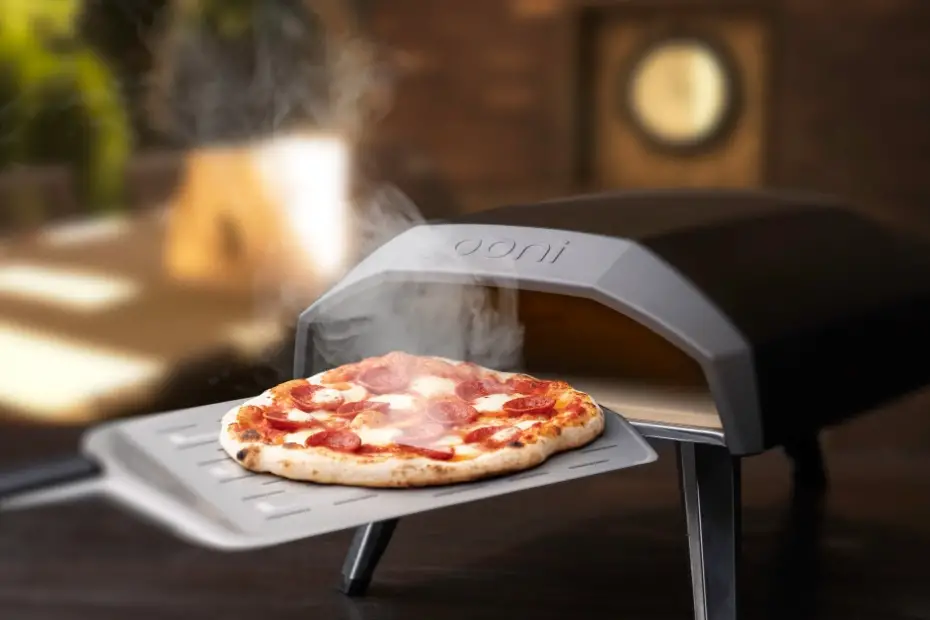Pizza ovens are a wonderful way to share a homecooked, wood-burned pizza with friends and family. Whether you’re considering a counter top oven or a portable oven –
There is something satisfying about making a pizza with your own hands, created in your own oven, and consumed in your home or outdoors. Yet there are many ways to use a pizza oven and, when the party’s over, how to clean a pizza oven.
Outdoor pizza ovens are great in accommodating different individual tastes and creating a mouth-watering pizza experience. Since the pizzas are usually homemade, people can customize their own pizza, or two people can create their own flavor profile. Store-bought pizzas are great. However, there is nothing better than one you made yourself.
In discussing how a pizza oven works, we need to first explore what an outdoor pizza oven really is.
DISCLOSURE: This post may contain affiliate links, meaning when you click the links and make a purchase, we receive a commission at no extra cost to you.
What Exactly is an Outdoor Pizza Oven?
Outdoor pizza ovens are specialized devices designed to cook pizzas at very high temperatures. Available in multiple sizes and types, there are several options available.
The classic oven is comprised of brick. It is heated by utilizing a wood fire located in the oven. The downside of these ovens are they can take a long time to prepare beforehand, heat, maintain heat, and manage while cooking. Most people prefer gas flame ovens as they are easier.
Conversely, portable outdoor pizza ovens are gaining in popularity. They are easy to transport, have a small footprint, are quick to assemble, and can fit into small spaces.
They reach the same high temperatures as the classic ovens in a shorter amount of time. Most of them are fueled by gas, but some use wood pellets to generate a smoky wood flavor to the pizza.
How Do Pizza Ovens Work?
With a pizza oven, the fire isn’t what cooks the pizza – it’s all in the oven. Pizza ovens are heated first by wood or a glass flame. The dome and base then retain heat by trapping it in with bricks, tiles, and insulated layers. This is what allows the pizza oven to quickly reach temperatures over 800° F.
When the oven is fully heated, the pizza can be cooked. However, depending on the type of oven, heating can take minutes to hours. Classic ovens are larger, so there is more area to heat up. However, once heated, it remains that way for days.
Furthermore, if your base is comprised of tiles, when fully heated, your pizza dough will really cook from the heat. This is what will allow you to cook a pizza within two minutes.
Portable outdoor pizza ovens heat up in a matter of minutes and cook pizzas in two-to-five minutes.
How Are They Made?
They are created from several different materials. Materials are all chosen for how they’ll absorb vast amounts of heat. For a wood or gas fire, the heat is mostly retained by bricks found in the dome in the oven and on a tiled floor.
Since these products retain heat, this is what allows you to quickly heat your pizza.
Outside of the bricks, there are layers that trap heat like perlite and fiber insulation around the dome. Calcium silicate and a slab board underneath the tiled floor are also added for heat retention.
The steps to building a pizza oven are as follows:
- Create the sub-floor insulation
- Establish the sub-floor castable slab
- Install floor tiles
- Create brick dome, flume, opening, and entry arch
- Put in the fiber blanket insulation
- Reinforce it using mesh
- Cast the render layer
Which is Better: Gas- or Wood-fired Ovens?
This is a big decision when looking at full-sized ovens. The reality is that neither type is inherently better. Each contains its own pros and cons. Each is better depending on the ultimate use.
Wood-fired ovens create the most rustic and authentic culinary experiences imaginable. Most people find operating them to be joyful and harmonious. However, for others, they find creating the fire to be annoying because of the effort that it takes.
Experts say these types of ovens provide for the best flavor. The slightly crisp, burned edge is what provides that little something special to the pizza that you can’t obtain using other methods. Additionally, you can play with flavor according to the type of wood you use.
Fruitwoods (hickory and apple) and hardwoods boost the number of flavors available. However, the cost can be pricey. Firewood is great, but you need good hardwood which means that you need hardwood that is close to dry.
The detriment is that you need to pay constant attention to it for good results. It needs to be constantly tended, and cooking becomes an art. The learning curve is a bit steeper on these ovens as there are many variables involved and quirks that you need to overcome.
Meanwhile, gas pizza ovens are for people who appreciate simplicity and reliability. They don’t want to fuss over tending to a pizza oven or fueling a fire.
Gas ovens heat quicker (30 minutes) versus the one-to-two hours of wood ovens. It is more of a set-it-and-forget-it type of scenario overall. While most people cook pizzas in these ovens, you can also do roasts, naan, and some breads.
They are also cheaper to run.
General Cooking Tips
Here are some basic tips when cooking with your pizza oven:
- Start the oven early. For a wood oven, it’s two-to-three hours, and for gas, it’s 30 minutes to one hour.
- Check temperature prior to cooking. The dome should be white with carbon or ash burned off.
- For a Neapolitan pizza, ensure there is a flame. It will cook with a lack of flame, but the absence of the additional heat on the top of the pizza makes the process longer and the top will be less crispy.
- Dough should be well-floured to avoid sticking.
- If the pizza is burning, hold the peel between the fire and the pizza to help even things out.
- Keep the pizza in the same spot while cooking.
- For extra char, place the pizza on the peel and keep it close to the top of the dome. Extra exposure allows the toppings and cheese additional heat exposure.
How to Clean a Pizza Oven
Pizza ovens are easy to clean and maintain. By using these simple steps, cleanup can be done quickly and easily:
- Collect ash after the oven has fully cooled. For some ovens, you may need to wait until the following day. Ash rakes can collect wood and ash remnants at the opening of the oven.
- Remove the ash with a fireplace shovel and ash rake. Collect it in a covered ashcan for easy disposal. You can also add it to a compost bin.
- Scrape off the caked-on debris with an oven brush. The brush should have brass of copper bristles to scrape off all materials effectively. Refrain from adding soaps/solvents.
- Sweep everything out.
For a gas oven, remove the pizza stone. Wipe it with a soft, damp cloth. Use a brass or copper oven brush to remove debris. While the stone is removed, spray the interior with white vinegar. Wipe with a damp cloth. Reinsert the stone, and you are done.
Need more info on cleaning a pizza oven? Check out our article on How to Clean a Pizza Oven!
Which type of pizza oven is right for you? Only you can answer that. If you find tending to a wood-burning oven therapeutic, then choose that one. If you want something quick and easy, choose a gas-operated one.

Hey there, I’m Greg Palmer, and I’m thrilled to share my story with you. Together with my brother Tim, I run the website GoodLifePizzaOvens.com, and it’s been quite the journey!
Our roots run deep in a beautiful countryside where we spent our childhood surrounded by nature’s wonders. Those were the days of horseback rides, fixing fences, rounding up cattle, and the never-ending quest to catch chipmunks raiding the grain barrel. But among all the adventures, that one special summer stands out, etched in our hearts forever—a time we both cherish dearly.
